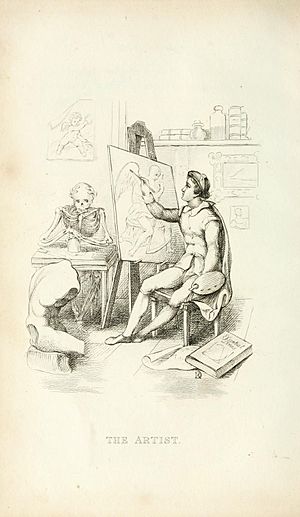Richard Dagley facts for kids
Richard Dagley (born around 1761, died 1841) was an English artist. He was known for his paintings and for creating illustrations for books.
Contents
Early Life and Family
Richard Dagley was born in London, England. He was baptized in January 1762. From 1770 to 1777, he attended Christ's Hospital school. After school, he became an apprentice to a jeweller and watchmaker.
In 1785, Richard Dagley married Elizabeth Cousen. They had ten children together. Only one of their children, their daughter Elizabeth Frances Dagley, lived to be an adult. She grew up to become a writer of children's books.
Artistic Career
Richard Dagley was a very busy artist. He showed his paintings at the Royal Academy in London many times. Between 1785 and 1833, he displayed 60 different works there. Most of these were "genre pictures," which are paintings that show scenes from everyday life.
Dagley also worked in other art forms. He helped his friend Henry Bone by adding enamel to watches and jewelry. He created several medals. He also painted beautiful pictures using watercolors. For a while, he taught drawing at a girls' school in Doncaster.
Writing and Illustrations
Richard Dagley also wrote about art for a newspaper called the Literary Gazette. In 1804, he published his first book, Gems Selected from the Antique. He drew and engraved all the pictures for this book himself. Engraving is a way of carving designs onto a surface to print images.
He later published a book to teach people how to draw in 1818. In 1822, he released another book about gems. This book included poems by a writer named George Croly.
Dagley also made funny illustrations for other books. He drew pictures for Isaac D'Israeli's book Flim-Flams (1805). He also illustrated a poem called Takings by Thomas Gaspey (1821). For Takings, Dagley wrote an essay about humor in art. He explained that he started drawing funny pictures after working on serious art.
One of his most famous works was Death's Doings (1826). This book explored the idea of death. It was inspired by an older artwork called Dance of Death. Dagley wanted to show how books could have nice pictures without being too expensive.
A pastel portrait of Richard Dagley, painted by John Raphael Smith, still exists today.
Later Life and Death
Richard Dagley passed away on April 1, 1841. He died from the flu at his home in London. He was buried at St Mary Abbots church in Kensington.
In Literature
Richard Dagley's art inspired other writers. In 1822, a poet named Letitia Elizabeth Landon wrote three poems based on his drawings. These poems were published in the Literary Gazette. She also wrote a poem about his painting Cupid and Swallows Flying from Winter. This poem appeared in her book Poetical Sketches of Modern Pictures (1825).
Later, Letitia Elizabeth Landon wrote four more poems for the 1827 edition of Dagley's book Death’s Doings. Another poet, Felicia Hemans, also contributed two poems to Death’s Doings.


